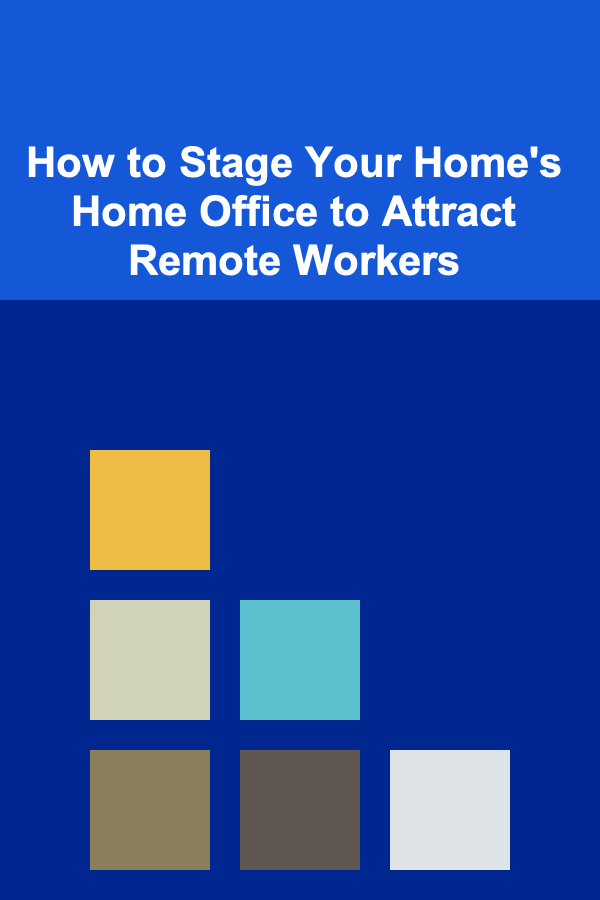
How to Stage Your Home's Home Office to Attract Remote Workers
ebook include PDF & Audio bundle (Micro Guide)
$12.99$5.99
Limited Time Offer! Order within the next:

In recent years, the shift towards remote work has been accelerating. More and more people are seeking homes with functional spaces that cater to their professional needs, such as home offices. For many buyers, a well-designed home office is not just a bonus but a necessity. Staging your home office to attract remote workers can set your home apart in a competitive real estate market. In this comprehensive guide, we'll explore how to stage your home office to appeal to the growing number of remote workers.
Understand the Remote Worker's Needs
Before diving into the specifics of staging, it's essential to understand the unique requirements of remote workers when choosing a home office space. A remote worker's home office needs to balance functionality with comfort, supporting long hours of work without sacrificing a sense of peace or relaxation.
Remote workers typically look for the following:
- Privacy and Quiet: Many remote workers need a quiet environment where they can focus without distractions. This is especially important for people in roles that require intense concentration or virtual meetings.
- Natural Light: Access to natural light is a big plus, as it helps reduce eye strain and contributes to a healthier work environment. Studies have shown that exposure to natural light can boost productivity and mental well-being.
- Ergonomic Furniture: Given the extended hours spent working, ergonomics are crucial. Comfortable chairs and desks that promote good posture are essential for preventing physical strain.
- Storage and Organization: A clutter-free space can lead to better productivity and a sense of calm. Remote workers often require storage solutions to keep their work materials organized and easily accessible.
- Technology Readiness: A home office needs to be equipped with sufficient electrical outlets, fast internet, and a layout that accommodates modern technology such as laptops, printers, and monitors.
By understanding these needs, you can tailor your home office staging to meet the expectations of remote workers.
Choose the Right Space for the Home Office
One of the first steps in staging a home office is choosing the right location. Not every room in the house is suitable for a home office. Ideally, the space should be separate from the rest of the living areas to minimize distractions and create a distinct boundary between work and personal life.
a. Convert Unused Rooms
If you have an unused bedroom, large closet, or attic space, consider converting it into a home office. This provides an opportunity to create a dedicated workspace without disrupting the flow of the rest of the home.
b. Repurpose a Corner or Nook
If a separate room isn't available, look for unused corners or nooks that could be turned into a functional work area. Even in an open-plan space, carving out a small area with a desk and storage can provide an office feel without requiring an entire room.
c. Consider Noise and Privacy
The location of your home office should also take noise and privacy into account. A space away from the living room, kitchen, or high-traffic areas will be ideal. Consider soundproofing or using noise-dampening furniture or decor if the area is near noisy parts of the house.
Create an Inviting and Professional Ambiance
A home office should be professional enough for video calls while also feeling comfortable and inviting. You want to create a space where remote workers can feel productive but also relaxed enough to recharge during breaks. Staging this balance is key.
a. Neutral Color Palette
Neutral colors like white, gray, beige, or soft blues create a calm, professional atmosphere. These tones are not only universally appealing but also work well in photographs, ensuring that your home office looks good in online listings.
- Walls: If the room's walls are painted in bold or dark colors, consider repainting with lighter, neutral shades. Light tones can make the space feel larger, brighter, and more inviting.
- Furniture: Choose simple, modern furniture with clean lines. Opt for neutral-colored desks and chairs that will appeal to a broad range of tastes.
b. Add Personal Touches
While it's important to keep the space neutral, don't forget to add touches of warmth and personality. Subtle decor elements, like a potted plant, a stylish lamp, or a framed artwork, can help create a more welcoming environment without making the space feel overly personalized.
- Art and Decor: Choose artwork or decor that complements the room's colors and gives the space a polished, professional feel. Avoid using overly personal items, such as family photos, which might detract from the buyer's ability to envision themselves in the space.
- Comfort Items: Include cozy elements, such as a throw blanket on a chair, to create an inviting atmosphere. These little touches can make the space feel more like an enjoyable work environment than a stark office.
c. Ergonomic Furniture
Remote workers spend long hours sitting at their desks, so ergonomic furniture is crucial. Make sure the furniture in your staged home office is comfortable and functional.
- Desk: Choose a desk that provides enough space for a computer, notebooks, and other essentials. A simple, clean desk with minimal clutter will make the space appear larger.
- Chair: An ergonomic chair with adjustable height, lumbar support, and armrests will make the space much more appealing to remote workers. This is a key feature that buyers will notice, especially if they work from home full-time.
- Standing Desks: If possible, consider incorporating a standing desk or a convertible desk that can be adjusted for sitting or standing. This is an increasingly popular option among remote workers seeking to improve their posture and reduce the health risks associated with sitting for long periods.
Incorporate Smart Storage Solutions
A cluttered home office can hinder productivity and make the space feel smaller. Remote workers will appreciate a space that offers plenty of storage options to keep their work materials organized.
a. Bookshelves and Shelving Units
Bookshelves and wall-mounted shelving units can help create additional storage while saving floor space. Use these to store books, files, and decorative items. Ensure that shelves are neatly organized to convey a sense of order.
- Closed Storage: If you have filing cabinets or boxes, keep them organized and tucked out of sight. Closed storage options help keep the room looking neat and uncluttered.
- Open Storage: If you opt for open shelving, be sure to keep the items on display minimal and tidy. A few decorative items, such as plants or framed artwork, can help enhance the aesthetic of the office.
b. Multi-Functional Furniture
Furniture that serves more than one purpose can be very attractive to remote workers. Consider incorporating pieces like a desk with built-in storage or an ottoman that doubles as a storage unit. These types of furniture maximize the functionality of the space while maintaining a clean and organized look.
- Storage Bins and Trays: Consider using storage bins or trays to keep small items organized. Label them to add an extra touch of tidiness and make it easy for buyers to imagine themselves using the space.
- File Cabinets: If you need file cabinets, choose modern, minimalist designs that blend seamlessly with the rest of the decor.
Enhance Lighting for Productivity
Lighting plays a significant role in creating a productive and inviting atmosphere in your home office. Proper lighting can enhance mood, reduce eye strain, and create an environment conducive to work.
a. Natural Light
Natural light is one of the most desirable features in a home office. A room with large windows or access to daylight makes the space feel more open and vibrant. Ensure that your home office is not obstructed by heavy curtains or blinds that block natural light.
- Maximize Natural Light: Open the blinds and let as much natural light in as possible. Clean windows will ensure that light is unobstructed.
- Window Treatments: Use light, airy curtains or blinds to filter the light without blocking it entirely. This helps maintain a bright, cheerful atmosphere without the glare of direct sunlight.
b. Task Lighting
In addition to natural light, task lighting is essential for remote workers, especially if they spend long hours in the office.
- Desk Lamp: A desk lamp with adjustable brightness can help remote workers create the right lighting for various tasks, whether they're reading, writing, or participating in video calls.
- Ambient Lighting: Use ceiling lights, floor lamps, or pendant lights to provide soft, ambient lighting throughout the room. This prevents the space from feeling too dim or stark.
Stage for Virtual Meetings
For remote workers, the home office will often serve as the backdrop for virtual meetings. It's important to make sure that your office is staged in a way that looks professional on video calls.
a. Background Considerations
When staging a home office for virtual meetings, consider the wall or backdrop behind the desk. A neutral, clutter-free background will give the space a clean, polished look during video calls.
- Wall Color: Light, neutral wall colors like beige or soft gray make a great backdrop for video calls. Avoid using bold colors or busy patterns, which can be distracting.
- Decor: Keep decor minimal but professional. A small plant or framed piece of art can provide a touch of personality without distracting from the conversation.
b. Camera Positioning
When setting up the desk, position it so that the desk's edge is aligned with the camera's view. Make sure the desk is not too cluttered, and the lighting falls evenly across your face for video calls.
Add Personal Touches without Overdoing It
While a home office should be staged to be functional and professional, it's important to add just enough personality to make the space feel warm and inviting. Remote workers will appreciate a space that feels both productive and personal.
- Personal Art: Consider adding a piece of artwork that reflects the style of the home without being too personal.
- Functional Decor: Choose decor that serves both a functional and aesthetic purpose, such as a stylish clock or a desk organizer.
- Comfortable Accents: Include a comfortable chair cushion, a decorative throw, or a cozy rug to soften the space and make it feel welcoming.
Conclusion
Staging your home office to attract remote workers requires a careful balance of functionality, comfort, and professionalism. By understanding the needs of remote workers and thoughtfully designing your home office space, you can create an inviting environment that enhances productivity while providing a sense of peace and relaxation. With the right lighting, ergonomic furniture, and organized storage, you can craft a home office that will appeal to the growing market of remote workers, helping your property stand out in today's competitive real estate market.
Reading More From Our Other Websites
- [Needle Felting Tip 101] Best Eco‑Friendly Yarn Choices for Sustainable Needle Felting Projects
- [Skydiving Tip 101] The Evolution of Skydiving Canopies: From Early Parachutes to Modern Wings
- [Home Cleaning 101] How to Clean and Care for Your Wooden Floors
- [Tiny Home Living Tip 101] Best Multi‑Functional Furniture Ideas for Tiny Homes with Small Pets
- [Home Cleaning 101] How to Clean Your Windows for a Streak-Free Shine
- [Tiny Home Living Tip 101] Best Ways to Insulate a Tiny Home for All Seasons
- [Sewing Tip 101] The Ultimate Guide to Choosing the Right Sewing Needle for Every Fabric
- [Home Budget Decorating 101] How to Update Your Kitchen with Affordable Decor Ideas
- [Organization Tip 101] How to Choose the Best Paint Colors for Your Home Walls
- [Paragliding Tip 101] Soaring Sustainably: Top Eco‑Friendly Practices Every Paraglider Should Adopt

How To Make Vegan Coffee Drinks (Dairy-Free)
Read More
How to Stock Up on Baby Clothing for the First Year: An Actionable Guide
Read More
How to Use a Checklist to Achieve Your New Year's Resolutions
Read More
10 Tips for Legal Assistants to Excel in E-Discovery
Read More
10 Tips for Future-Proofing Your IoT Architecture Design
Read More
How to Choose the Best Anti-Fog Coating for Your Glasses
Read MoreOther Products

How To Make Vegan Coffee Drinks (Dairy-Free)
Read More
How to Stock Up on Baby Clothing for the First Year: An Actionable Guide
Read More
How to Use a Checklist to Achieve Your New Year's Resolutions
Read More
10 Tips for Legal Assistants to Excel in E-Discovery
Read More
10 Tips for Future-Proofing Your IoT Architecture Design
Read More